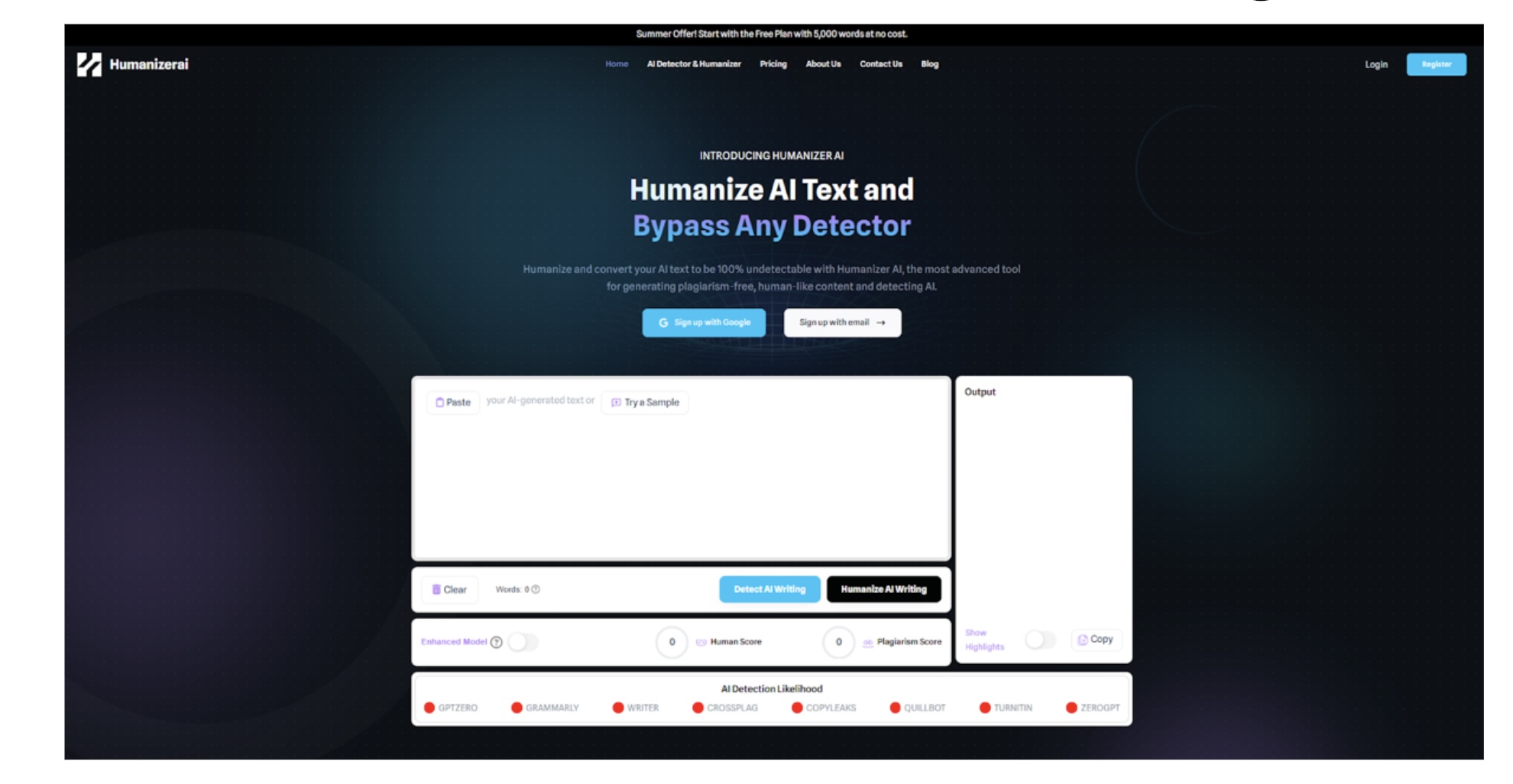Writing has become as easy as possible with AI. Whether in blog posts and essays or product descriptions and social media captions, ChatGPT and its latest cohorts, Claude and Gemini, are some of the tools that make writers create content within minutes. But while with that speed comes the new obligation of making sure the content doesn’t give up on quality standards and doesn’t get detected as AI-generated content.
This is why more and more writers are now making sure to run their work through an AI detector and publishing it.
Whether you write across a brand, as a guest, to clients, or using a scholarly paper, having AI-based plagiarism checkers such as Turnitin or GPTZero flag you can lose credibility or even your source of income.
In this post, we’ll explore why more writers are relying on AI detectors before publishing, the risks of skipping this step, and why Humanizer AI is emerging as the most effective solution, not just for detection, but for rewriting and protecting your work from being flagged.
The Rise of AI Content And the Detection Backlash
From small business owners to students to content agencies, people are using AI to write more, faster. And there’s nothing wrong with that until the content starts sounding robotic, repetitive, or too “clean.”
That’s exactly what detection tools look for.
Platforms like:
- Turnitin
- GPTZero
- Copyleaks
- Sapling
are built to flag content that matches AI-writing patterns. These patterns might include predictable sentence structure, repetitive phrases, or overly formal tone.
Writers who hit generate and copy-paste content without checking often face problems like:
- Rejected submissions
- Suspended accounts
- Lower SEO performance
- Accusations of plagiarism or dishonesty
This is why AI detectors are joining the new publishing workflow. They are now not only acceptable in schools, they are acceptable to anyone who wants his or her content to be trusted.
The question today is how to operate with AI and not to fall into these traps. It is not enough to just type text into ChatGPT. Already, writers and producers of content are finding it necessary to have codes or other software applications that are not just detecting AI-based writing but also remaking it to appear authentic, real, and not noticeable.
Why Writers Can’t Ignore AI Detection
Let’s break down why running content through an ai detector before publishing is becoming essential:
Clients and Editors Expect Originality
If you’re a freelancer or content marketer, delivering content that sounds human is part of the job. Many clients now run your work through detection tools before accepting it. If your article is flagged, the client might request a rewrite or cancel the project altogether. It’s no longer about just being fast, it’s about being credible.
Search Engines Are Cracking Down
Google does not want robotic text, just useful content. Even though technically your blog post may be correct, you wrote it with an AI, so it may not be visible in search results because it sounds (reads) machine-written. SEO today is not only about the tone of keywords, their relevance, and the interest of the reader.
Using a detector helps you catch and rewrite those signals before publishing.
Academic Penalties Are Real
Students submitting essays written by AI are at risk. Even if the ideas are theirs, using AI to write them can trigger detection systems like Turnitin. An AI flag can result in academic warnings or worse. Schools are now trained to spot AI tone and formatting inconsistencies.
Brand Trust Is On the Line
If you’re publishing under a company or personal brand, your writing needs to connect emotionally. Robotic tone destroys trust. Your readers know when something doesn’t feel real. Using a detector helps ensure your content reflects your voice, not a machine’s.
Legal and Ethical Responsibility
There are also ethical considerations. Some industries require transparency and originality by default. If a financial advisor, healthcare professional, or journalist publishes AI-generated content without editing or verifying it, it may cross legal lines.
And beyond legality, there’s a simple question of pride in your work. Real professionals want their content to reflect human insight, not just data scraping.
Why Humanizer AI Is More Than Just an AI Checker
Plenty of tools can detect AI. But what happens when your content is flagged?
That’s where Humanizer AI stands out.
It’s not just an ai checker, it’s a full platform designed to help you:
- Detect AI content
- Rewrite it into natural, human-sounding language
- Pass detection tools like Turnitin and GPTZero
- Preserve your original meaning, tone, and message
While traditional AI detectors stop at the problem, Humanizer AI provides the solution.
Instead of leaving you with a flagged document and no way to fix it, Humanizer AI helps transform it. It does more than reword. It restructures. It rewrites. It gives your content back its soul.
How Humanizer AI Helps Writers Rewrite and Publish Safely
Here’s how writers are using Humanizer AI to protect their content before publishing:
Step 1: Paste Your Content
Whether it’s from ChatGPT, Claude, or your mixed writing, drop it into Humanizer AI’s dashboard.
Step 2: Run AI Detection
The tool instantly evaluates your content using patterns similar to Turnitin and GPTZero.
You’ll see a score showing how likely it is that your content will be flagged as AI-generated. That score gives you clear insight and actionable direction.
Step 3: Use the Humanizer Tool
Select rewrite to rewrite your content, in case it rates high in AI recognition. It is not a simple rewording. Humanizer AI reforms your sentence structure, changes the tone, and adds a natural rhythm to your text. It is like having an editor who knows just what to correct.
Step 4: Recheck and Publish
After doing the rewrite, you will then be able to re-test it using the AI detector again, and you will notice that most of the time, the detection score will be reduced drastically.
Publishing is now safe because you know what you write reads as written by a person, not a program.
Real-Life Use Cases
Freelancers & Agencies: Many freelancers now use Humanizer AI to clean up AI drafts before sending them to clients. This helps them avoid revisions and maintain professionalism. Instead of risking a reputation on quick AI content, they enhance it and deliver polished results.
Students: Students use it to rewrite AI-assisted essays so they can avoid Turnitin detection while still using AI to help them think, outline, or brainstorm. It’s a bridge between using tools and maintaining academic integrity.
Bloggers & SEO Writers: Bloggers take AI-generated outlines and run them through Humanizer AI to make sure they’re readable, emotional, and free from detection risks. The result? More authentic engagement from readers.
Business Teams: Marketing departments and business owners use the platform to make AI-written landing pages and emails more relatable, without starting from scratch. That saves time without compromising brand trust.
What Makes Humanizer AI Different
Most AI detectors give you a “yes” or “no.” Humanizer AI goes further by actually fixing the issue.
Here’s what sets it apart:
- Built-in AI detection and rewriting, Everything in one platform
- Trained on multiple LLMs. Handles content from ChatGPT, Gemini, Claude, and more
- Natural rewrites are not robotic, not awkward
- Real-time results Know immediately if your content will pass
- Supports SEO and academic use. Whether you’re writing for rankings or grades
In short, it’s not just smarter, it’s made for real-world writing needs.
Other Tools on the Platform
In addition to the AI detector and humanizer tool, the platform offers:
- AI Stealth Writer: Generates content that’s human-like from the start
- Essay Rewriter: Helps students rewrite safely
- Paraphraser: Tweak small sections while keeping your message
- Plagiarism Checker: Keep your work 100% original
- SEO Writer: For content teams focused on Google rankings
Humanizer AI isn’t trying to replace your brain. It’s here to empower it.
Conclusion
In today’s world, just writing content isn’t enough. You need to know how it will be received by search engines, by clients, by teachers, by audiences.
Using an ai detector before publishing isn’t about paranoia. It’s about quality control. It’s about caring how your message is delivered.
And with a tool like Humanizer AI, you’re not just checking your content—you’re improving it, rewriting it, and making it better.
It’s a safety net for your voice. A shield for your brand. And a passport through the gates of AI detection.

































